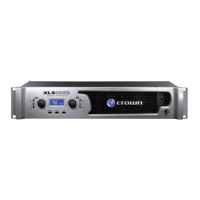wave-secondary rectifier, and control circuitry. In addition two components are added to
form a resonant tank which significantly increases the overall efficiency of the converter.
The IGBTs, Q903 and Q906, switch at approximately 40% duty cycle each at a frequency
of 96kHz. During their on time period the IGBTs transfer energy from the primary bulk
storage (C911, C912, C955, and C956) and the AC line through the resonant tank
(C923//C954 & L904) to the transformer, T901. The energy is magnetically coupled to
the secondary of the transformer, rectified by D905-D908, and stored in C925 & C926
for the amplifier to use.
The transformer (T901) magnetizing inductance results in a small triangular shaped
current flow in the primary of the transformer. This current provides a soft switching
action to the IGBTs by charging/discharging the parasitic capacitance of the devices
during dead time such that the IGBT turns on with near zero voltage across its collector
to emitter terminals. This reduces power loss on the IGBTs. As the power output
increases, the voltage developed across the resonant capacitor (C923//C954) reduces this
effect. Another form of soft switching is also employed with the additional of
components: C923//C954 & L904 that form a series resonant tank. The resonant
frequency of this tank circuit is greater than that of the switching frequency. The tank
forces the load current to be drawn in half sinewave portions. Thus the current drops to
near zero before the IGBTs gate is turned off. This is a form of zero current turn off,
which greatly reduces the dissipation associated with the turn off of the IGBTs, and thus
results in higher power supply efficiency.
The current through the converter is passively limited two main variables. The maximum
current through the converter is directly proportional to the driving “VBULK” voltage
and by the impedance of the tank itself, C923//C954 & L904. This along with the proper
selection of semiconductors (Q903, Q906, and D905-D908) and temperature limiting
result in a very robust design.
A single auxiliary winding on the transformer is half-wave rectified by D909 & D910,
creating both the “+LV” and “-LV” unregulated supplies. Another supply is also derived
from this winding via an AC coupled voltage doubler referenced to the “-VCC” supply.
This output is then regulated to +12V referenced to “-VCC” via U3 for the gate drive ICs
U102 & U202.
Modulating the main converter is a control IC with an integrated high side gatedriver
(U902), and a comparator (U903) that controls when the converter starts and stops. Both
sections of the comparator U903 outputs must be high for the converter to run.
Comparator section U903A output goes high when the “+15V_CONTROL” voltage
above 13V and goes low when “+15V_CTRL drops below 12V. U903B enables the
power supply if the AC supply voltage above 75% of the nominal line voltage, and
disables it is the AC supply voltage is below 50% of nominal line.

